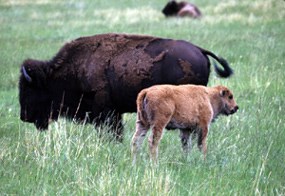
NPS (Jack O'Brien) (Note: Though Bighorn Canyon NRA does not have a bison herd, many visitors who drive the Ok-A-Beh Road in the North District sometimes see bison. That is because the road crosses Crow Tribal Land. The Crow Reservation contains a large herd, numbering upwards of 1,100 bison. Characteristics Both cows and bulls have two black horns. The tips are sharp and grow throughout their lifetime. They never shed nor drop off like antlers. These horns are made of the same material as human fingernails but are thicker and stronger. Their thick coats act as protective blankets – the cold doesn’t get in and the buffalo’s body heat doesn’t get out. Mating, Calving, And The Early Years As calves grow older, they roam farther from the cows, perhaps up to 50 yards. However when a cow utters a series of low-pitched grunts, the calf answers immediately in a high pitched grunt and runs to join her. Just before reaching the second year, their horns emerge and begin to curve. Noisemakers The buffalo feed about five times a day – just before dawn, mid-morning, mid-afternoon, one to two hours before sunset, and again around midnight. This feeding pattern is not as regular during the breeding season or in winter. In the early to mid 19th century and before, predators of bison were wolves and grizzly bears. Wolves would track and kill a single bison. A grizzly, on the other hand, would attack if it discerned that a lone buffalo was injured or sickly. Did You Know Buffalo were very important to sustain the physical and spiritual needs of the Crow people. They relied heavily upon the animal for their main source of food, clothing, and shelter.
|
Last updated: February 24, 2015
